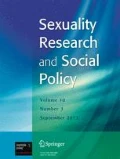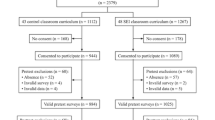Abstract
The study aimed to explore whether evidence-based elementary social-emotional learning (SEL) curricula [Promoting Alternative Thinking Strategies (PATHS)] focused on social problem-solving skills combined with sexual risk prevention lessons would have an impact on preventing the early onset of sexual intercourse. A 4-year longitudinal, randomized, controlled design was employed in which 24 elementary schools were assigned to receive the already in place SEL curriculum (control) or the enhanced PATHS curriculum (intervention) combined with sexual risk prevention lessons during grades 3–6. Social problem-solving skills were assessed in grade 6 through the use of a social problem-solving dilemma and sexual behavior was assessed in grades 6 and 7. Sexual activity rates were 9.1% and 21.1% in the sixth and seventh grades, respectively. While the direct effects of the intervention on sexual behavior were not significant, the intervention did indirectly have an effect through social problem-solving skills. Those receiving the intervention curriculum were more likely to focus on issues specific to a dilemma designed to assess problem-solving skills and adolescents using this social cognitive skill, in turn, were less likely to have engaged in sexual intercourse by the seventh grade. The results provide evidence of the positive impact of SEL on students’ social problem-solving skills and delay in initiating sexual intercourse.
Similar content being viewed by others
References
Alan Guttmacher Institute. (1991). Teenage sexual and reproductive behavior (facts in brief). New York: AGI.
Alan Guttmacher Institute. (1994). Sex and America’s teenagers. New York: AGI.
Barone, C., Weissberg, R. P., Kasprow, W. J., Voyce, C. K., Arthur, M. W., & Shriver, T. P. (1995). Involvement in multiple problem behaviors of young urban adolescents. Journal of Primary Prevention, 15, 261–283.
Barone, C., Ickovics, J. R., Ayers, T. S., Katz, S. M., Voyce, C. K., & Weissberg, R. P. (1996). High-risk sexual behavior among young urban students. Family Planning Perspectives, 28, 69–74.
Basen-Engquist, K., Coyle, K. K., Parcel, G. S., Kirby, D., Banspach, S. W., Carvajal, S. C., et al. (2001). Schoolwide effects of a multicomponent HIV, STD, and pregnancy prevention program for high school students. Health Education & Behavior, 28(2), 166–185.
Bierman, K. L., Coie, J. D., Dodge, K. A., Greenberg, M. T., Lochman, J. E., McMahon, R. J., et al. (2010). The effects of a multiyear universal social-emotional learning program: The role of student and school characteristics. Journal of Consulting and Clinical Psychology, 78, 156–168.
Brookman, R. (1988). Sexually transmitted diseases. In M. Levin & E. Anarney (Eds.), Early adolescent transitions (pp. 149–165). Indianapolis: Lexington Books/DC Health.
Cates, W. (1990). The epidemiology and control of sexually transmitted diseases in adolescents. Adolescent Medicine, 1, 409–428.
Chase, J., Kane W., Telljohann S. K., & Lezin N. (2004). HealthSmart Middle School: Abstinence & Puberty Santa Cruz, CA: ETR Associates
Committee for Children. (1992). Second Step. Seattle, WA: Committee for Children.
D’Zurilla, T. J. (1986). Problem-solving therapy: A social competence approach to clinical intervention. New York: Springer.
D’Zurilla, T. J., & Nezu, A. M. (1999). Problem-solving therapy: a social competence approach to clinical intervention (2nd ed.). New York: Springer.
Eaton, D. K., Kann, L., Kinchen, S., Ross, J., Hawkins, J., Harris, W. A., et al. (2006). Youth risk behavior surveillance—United States, 2005. MMWR Surveillance Summaries, 55, 1–108.
Greenberg, M. T., & Kusché, C. A. (1998). Preventive intervention for school-aged deaf children: The PATHS Curriculum. Journal of Deaf Studies and Deaf Education, 3, 49–63.
Greenberg, M. T., Weissberg, R. P., O’Brien, M. U., Zins, J. E., Fredericks, L., Resnik, H., et al. (2003). Enhancing school-based prevention and youth development through coordinated social, emotional, and academic learning. American Psychology, 58, 466–474.
Grunbaum, J., Kann, L., Kinchen, S., Williams, B., Ross, J., Lowry, R., et al. (2002). Youth risk behavior surveillance—United States 2001. Surveillance Summaries, 51(SS04), 1–64.
Harvey, S. M., & Spigner, C. (1995). Factors associated with sexual behavior among adolescents: A multivariate analysis. Adolescence, 30(118), 253–264.
Howard, M., & McCabe, J. (1990). Helping teenagers postpone sexual involvement. Family Planning Perspectives, 22, 21–26.
Jemmott, L. (1993). AIDS risk among black male adolescents: Implications for nursing interventions. Journal of Pediatric Health Care, 7(1), 3–11.
Jordahl, T., & Lohman, B. J. (2009). A bioecological analysis of risk and protective factors associated with early sexual intercourse of young adolescents. Children and Youth Services Review, 31, 1272–1282.
Kam, C., Greenberg, M. T., & Walls, C. T. (2003). Examining the role of implementation quality in school-based prevention using the PATHS curriculum. Prevention Science, 4(1), 55–63.
Kavanaugh, M., Jackson, A. S., Gaffney, J., Caplan, M., & Weissberg, R. P. (1999) Sixth-grade Human Growth and Development Module - Revised 1999. New Haven Social Development Program: New Haven, CT.
Kinsman, J., Nakiyingi, A., Kamali, A., Carpenter, L., Quigley, M., Pool, R., et al. (2001). Evaluation of a comprehensive school-based AIDS education programme in rural Masaka, Uganda. Health Education Research, 16(1), 85–100.
Kirby, D. (1992). School-based programs to reduce sexual risk-taking behavior. Journal of School Health, 62(7), 280–287.
Kirby, D., Barth, R., Leland, M., & Fetro, J. (1991). Reducing the risk: Impact of a new curriculum on sexual risk-taking. Family Planning Perspectives, 23(6), 253–263.
Kirby, D., Short, L., Collins, J., Rugg, D., Kolbe, L., Howard, M., et al. (1994). School-based programs to reduce sexual risk behaviors: A review of effectiveness. Public Health Reports, 109(3), 339–360.
Korum, K. & Hladky, J. (1991). Building Blocks: An AIDS Curriculum Guide for Early Elementary Educators. Washington, DC: American National Red Cross.
Kusché, C. A., & Greenberg, M. T. (1994). The PATHS curriculum. Seattle: Developmental Research and Programs.
Lammers, C., Ireland, M., Resnick, M., & Blum, R. (2000). Influences on adolescents’ decision to postpone onset of sexual intercourse: A survival analysis of virginity among youths aged 13 to 18 years. Journal of Adolescent Health, 26, 42–48.
Lemerise, E. A., & Arsenio, W. F. (2000). An integrated model of emotion processes and cognition in social information processing. Child Development, 71, 107–118.
Levy, S., Perhats, C., Weeks, K., Handler, A., Zhu, C., & Flay, B. (1995). Impact of a school-based AIDS prevention program on risk and protective behavior for newly sexually active students. Journal of School Health, 65(4), 145–151.
MacKinnon, D. P. (2008). Introduction to statistical mediation. New York: Lawrence Erlbaum.
MacKinnon, D. P., Krull, J. L., & Lockwood, C. M. (2000). Equivalence of the mediation, confounding and suppression effect. Prevention Science, 1, 173–181.
Marsiglio, W., & Mott, F. (1986). The impact of sex education on sexual activity, contraceptive use, and premarital pregnancy among American teenagers. Family Planning Perspectives, 18(4), 151–161.
Office of Technology Assessment. (1995). The effectiveness of AIDS prevention efforts. Washington, DC: U.S. Congress, OTA Background Paper.
Porter, C., Oakley, D., Ronis, D., & Neal, R. (1996). Pathways of influence on fifth and eighth graders’ reports about having had sexual intercourse. Research in Nursing & Health, 19, 193–204.
Riggs, N. R., Greenberg, M. T., Kusché, C. A., & Pentz, M. A. (2006). The mediational role of neurocognition in the behavioral outcomes of a social-emotional prevention program in elementary school students: Effects of the PATHS Curriculum. Prevention Science, 7, 91–102.
Romer, D., Black, M., Ricardo, I., Feigelman, S., Kalijee, L., Galbraith, J., et al. (1994). Social influences on the sexual behavior of youth at risk for HIV exposure. American Journal of Public Health, 84, 977–985.
Rosenberg, P. (1995). Scope of AIDS epidemic in the United States. Science, 270, 1372–1375.
Rosenthal, S., Biro, F., Succop, P., Cohen, S., & Stanberry, L. (1994). Age of first intercourse and risk of sexually transmitted disease. Adolescent and Pediatric Gynecology, 7, 210–213.
Ruchkin, V., Schwab-Stone, M., & Vermeiren, R. (2004). Social and Health Assessment (SAHA): Psychometric development summary. New Haven: Yale University.
Schonfeld, D., & Quackenbush, M. (1996a). Teaching Kids About...How AIDS Works. A Curriculum for Grades K-3. Santa Cruz, ETR Associates.
Schonfeld, D., & Quackenbush, M. (1996b). Teaching Kids About...How AIDS Works. A Curriculum for Grades 4–6. Santa Cruz, ETR Associates.
Schwab-Stone, M. E., Ayers, T. S., Kasprow, W., Voyce, C., Barone, C., Shriver, T., et al. (1995). No safe haven: A study of violence exposure in an urban community. Journal of the American Academy of Child and Adolescent Psychiatry, 34, 1343–1352.
Seidman, S. N., Mosher, W. D., & Aral, S. O. (1994). Predictors of high-risk behavior in unmarried American women: Adolescent environment as risk factor. Journal of Adolescent Health, 15(2), 126–132.
Sellers, W. L. (2005). Puberty: The Wonder Years. Mt. Pleasant, MI: EMC at Central Michigan University
Shaver, M. A., & Boyer, C. B. (1991). Psychosocial and behavioral factors associated with risk of sexually transmitted diseases, including human immunodeficiency virus infection, among urban high school students. Journal of Pediatrics, 119(5), 826–833.
Shrout, P. E., & Bolger, N. (2002). Mediation in experimental and nonexperimental studies: New procedures and recommendations. Psychological Methods, 7, 422–445.
Siegel, D., Aten, M., & Enaharo, M. (2001). Long-term effects of a middle school and high school based HIV sexual risk prevention intervention. Archives of Pediatric and Adolescent Medicine, 155, 1117–1126.
St. Lawrence, J., Brasfield, T., Jefferson, K., Alleyne, E., O’Bannon, R., & Shirley, A. (1995). Cognitive-behavioral interventions to reduce African American adolescents’ risk for HIV infection. Journal of Consulting and Clinical Psychology, 63(2), 221–237.
Stanton, B., Fang, X., Li, X., Feigelman, S., Galbraith, J., & Ricardo, I. (1997). Evolution of risk behaviors over 2 years among a cohort of urban African American adolescents. Archive of Pediatric and Adolescent Medicine, 151, 398–406.
Stryker, J., Coates, T., DeCarlo, P., Haynes-Sanstad, K., Shriver, M., & Makadon, H. (1995). Prevention of HIV infection: Looking back, looking ahead. Journal of the American Medical Association, 273(14), 1143–1148.
Turner, C., Ku, L., Rogers, S., Lindberg, L., Pleck, J., & Sonenstein, F. (1998). Adolescent sexual behavior, drug use, and violence: Increased reporting with computer survey technology. Science, 280, 867–873.
UNAIDS (1997). Impact of HIV and sexual health education on the sexual behavior of young people: a review updates. Joint United Nations Programme on HIV/AIDS.
United States Senate Select Committee on Children, Youth, and Families (1992). A decade of denial. Government Document.
Weissberg, R. P., Caplan, M., Bennetto, L., & Jackson, A. J. (1999) Sixth-grade Social Problem-Solving Module - Revised 1999. New Haven Social Development Program: New Haven, CT.
Zabin, L., Smith, E., Hirsch, M., & Hardy, L. (1986). Ages of maturation and first intercourse in black teenage males and females. Demography, 23, 595–605.
Acknowledgments
This study was funded by a research grant (RO1 HD045362: Comprehensive Elementary School Risk Prevention) from the National Institute of Child Health and Human Development (NICHD) awarded to David J. Schonfeld, MD.
Author information
Authors and Affiliations
Corresponding author
Rights and permissions
About this article
Cite this article
Schonfeld, D.J., Adams, R.E., Fredstrom, B.K. et al. Social–Emotional Learning in Grades 3 to 6 and the Early Onset of Sexual Behavior. Sex Res Soc Policy 9, 178–186 (2012). https://doi.org/10.1007/s13178-011-0077-7
Published:
Issue Date:
DOI: https://doi.org/10.1007/s13178-011-0077-7




